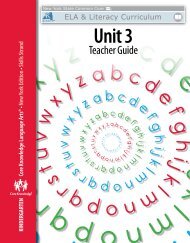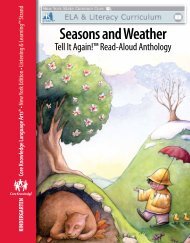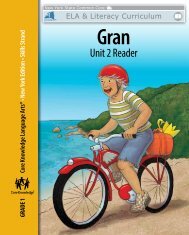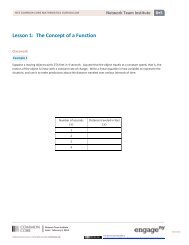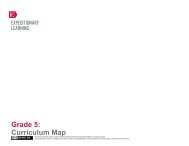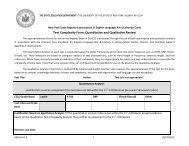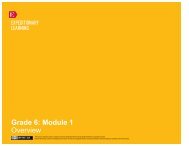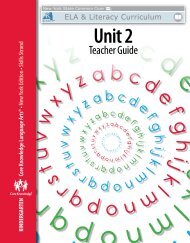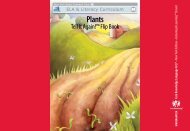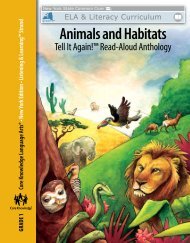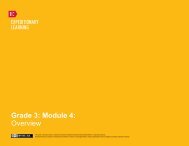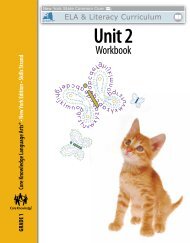- Page 1:
Grade 2 Core Knowledge Language Art
- Page 4 and 5:
Creative Commons Licensing This wor
- Page 7 and 8:
Alignment Chart for Unit 2 The foll
- Page 9 and 10:
Alignment Chart for Unit 2 Lesson 1
- Page 11:
Lesson Alignment Chart for Unit 2 1
- Page 14 and 15:
Week Two Day 6 (Lesson 6) Day 7 (Le
- Page 16 and 17:
and by introduced as Tricky Words.
- Page 18 and 19:
Assessment Opportunities As in Unit
- Page 20 and 21:
Word Walls If you have not already
- Page 22 and 23:
silent ‘e’. Or you may have use
- Page 24 and 25:
We classify the initial sounds in e
- Page 26 and 27:
Lesson 1 Basic Code Review Tricky W
- Page 28 and 29:
Warm-Up 10 minutes Introduce Spelli
- Page 30 and 31:
• Point to each spelling in bake
- Page 32 and 33:
• Ask students to turn to Workshe
- Page 34 and 35:
Purpose for Reading • Remind stud
- Page 36 and 37:
Bedtime Tales Story Chart Story Tit
- Page 38 and 39:
Lesson 2 Basic Code Review Tricky W
- Page 40 and 41:
Warm-Up 5 minutes Contraction Revie
- Page 42 and 43:
Individual Code Chart 1. ‘o_e’
- Page 44 and 45:
• Read with students the two-syll
- Page 46 and 47:
If some pairs finish early during s
- Page 48 and 49:
Lesson 3 Basic Code Review Spelling
- Page 50 and 51:
• Show students the Spelling Card
- Page 52 and 53:
Practice 10 minutes See Letter-Soun
- Page 54 and 55:
Main Idea and Key Details: The main
- Page 56 and 57:
Text From Student Reader • The te
- Page 58 and 59:
Lesson 4 Tricky Words Grammar Readi
- Page 60 and 61:
Tricky Word: who • Tricky: The le
- Page 62 and 63:
Introducing the story • Today’s
- Page 64 and 65:
• Sentences and phrases: 1. ride
- Page 66 and 67:
At a Glance Exercise Materials Minu
- Page 68 and 69:
Individual Code Chart 1. ‘oo’ >
- Page 70 and 71:
Previewing Spellings • Briefly re
- Page 72 and 73:
• Wiggle Cards: 1. shoot hoops 2.
- Page 74 and 75:
Student name 1 2 3 4 5 6 7 8 9 10 y
- Page 76 and 77:
Spelling 15 minutes Introduce Spell
- Page 78 and 79:
Analysis of Elements of a Fictional
- Page 80 and 81:
Title: Characters Setting Jane -has
- Page 82 and 83:
Lesson 7 Basic Code Review Spelling
- Page 84 and 85:
Today’s Spellings 20 minutes Revi
- Page 86 and 87:
• Work with students to first wri
- Page 88 and 89:
Lesson 8 Basic Code Review Spelling
- Page 90 and 91:
• Write the following words on th
- Page 92 and 93:
• Complete the remaining question
- Page 94 and 95:
Code Knowledge • Before today’s
- Page 96 and 97:
the Milk ther wuz a las namd jane s
- Page 98 and 99:
Warm-Up 5 minutes Quotation Marks
- Page 100 and 101:
Previewing Spellings • In previou
- Page 102 and 103:
Text from Student Reader • The te
- Page 104 and 105:
If some student pairs finish early,
- Page 106 and 107:
Advance Preparation • Write the f
- Page 108 and 109:
• Explain to students that by its
- Page 110 and 111:
Discussion Questions on “How the
- Page 112 and 113:
Spelling Analysis Directions Unit 2
- Page 114 and 115:
Lesson 11 Basic Code Review Grammar
- Page 116 and 117:
Write she is on the board. Based on
- Page 118 and 119:
Words with ‘ar’ 1. jar 2. car 3
- Page 120 and 121:
• Wiggle Cards: 1. start clapping
- Page 122 and 123:
Advance Preparation Write the follo
- Page 124 and 125:
Small Group Work Small Group 1: Fo
- Page 126 and 127:
Main Idea and Key Details: The main
- Page 128 and 129:
Take Home Material “The Pancake,
- Page 130 and 131:
At a Glance Exercise Materials Minu
- Page 132 and 133: • If the draft contains dialogue,
- Page 134 and 135: Take-Home Material “The Pancake
- Page 136 and 137: Warm-Up Practice Worksheet 14.1 Sou
- Page 138 and 139: Lesson 15 Spelling Test Reading Ob
- Page 140 and 141: Reading Time 20 minutes Whole Group
- Page 142 and 143: Supplemental Materials • Decodabl
- Page 144 and 145: Lesson 16 Student Performance Task
- Page 146 and 147: • Start a stopwatch or jot down a
- Page 148 and 149: Line Feature Source 1. ‘er’ 2.
- Page 150 and 151: WCPM Calculation Worksheet Student:
- Page 152 and 153: Unit 2 Pausing Point This is the en
- Page 154 and 155: Note to Teacher It will be most eff
- Page 156 and 157: Multiple Vowel Sounds and Spellings
- Page 158 and 159: • Say to the class/small group,
- Page 160 and 161: 1. not > note 2. bit > bite 3. man
- Page 162 and 163: oo/: Reading Minimal Pairs • Tell
- Page 164 and 165: ar/ versus /or/: 1. jar 3. farm 5.
- Page 166 and 167: Tricky Words Tricky Word Clues •
- Page 168 and 169: Suffix -ed: Complete the Sentence
- Page 170 and 171: Appendix A Grade 2 Scope and Sequen
- Page 172 and 173: • write words, phrases, and sente
- Page 174 and 175: • Read Tricky Words • read deco
- Page 176 and 177: • change story events to provide
- Page 178 and 179: eport, and poetry • gather inform
- Page 180 and 181: the students have been taught to pr
- Page 184 and 185: • We divide syllables with a schw
- Page 186 and 187: Assessments There are many opportun
- Page 188 and 189: Anecdotal Reading Record Week of: _
- Page 190 and 191: 3 5 Name 1.2 Name 1.3 Directions: A
- Page 192 and 193: 20 21 Name 4.2 20 Unit 2 © 2013 Co
- Page 194 and 195: 43 47 Name 9.3 Name 10.2 Directions
- Page 196 and 197: 65 71 Name 12.2 Name 13.2 The Panca
- Page 198 and 199: 92 97 Name PP1 5. Who went to eat t
- Page 200 and 201: 104 105 Name PP5 s c kn k t f p g g
- Page 202 and 203: 115 116 Name PP10 Directions: Have
- Page 204 and 205: 126 132 Name PP17 owl now out shout
- Page 206 and 207: 147 148 Name PP24 Print the words i
- Page 208 and 209: 158 159 Name PP30 Print yes or no o
- Page 210 and 211: 168 racing 1. Can we make the car g
- Page 212: CREDITS Every effort has been taken



